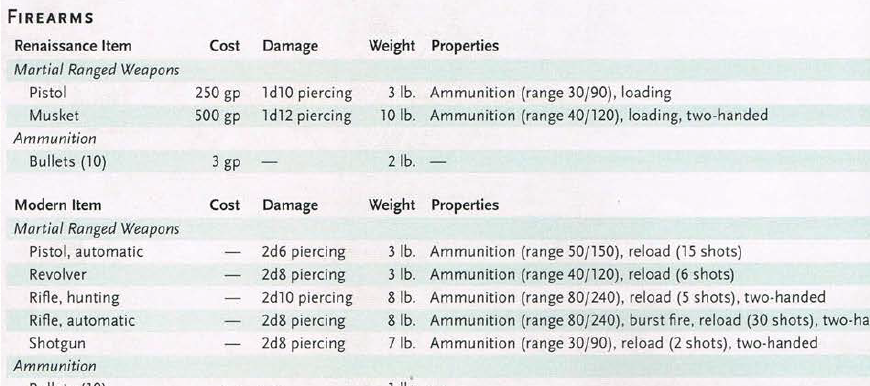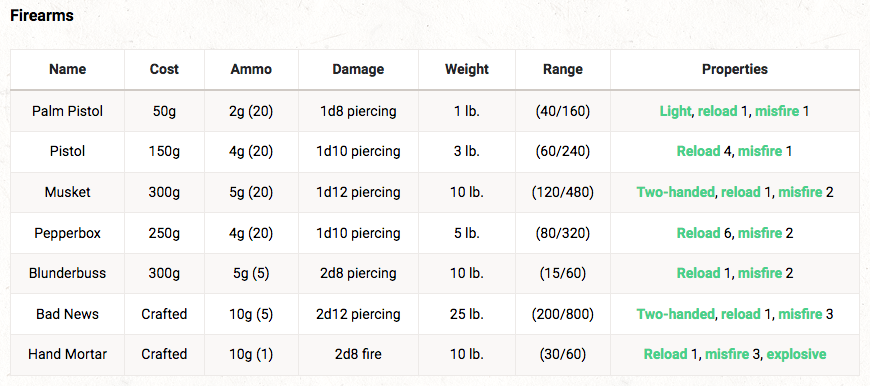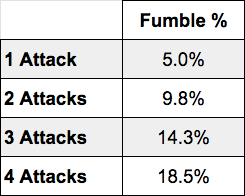What is the Gunslinger?
The Gunslinger is a homebrew subclass created by Matthew Mercer, famed Dungeon Master of the Critical Role actual play D&D show. The Gunslinger is a subclass for the Fighter class.
Perhaps owing to the fact that it was originally created for Pathfinder, the Gunslinger carries some vestiges that overlap with 5th Edition design. Instead of relying on the standard firearm mechanics presented in the Dungeon Master’s Guide (p. 268), the Gunslinger cooks up its own firearms table.


Note that the Gunslinger table includes a new property: Misfire.
Where does Gunslinger fumble?
The Gunslinger’s Misfire mechanic resembles “critical fumble” tables. By building on this cracked foundation, the frustrations become more prevalent as the Gunslinger levels up. Let’s walk through it.
Critical Fumbles
A “critical fail” is when you roll a 1. Rules as written (RAW) state that the only bad thing that happens when you roll a 1 is that you miss your attack. But, some DMs like to add additional penalties when a player rolls a 1. These results are oftentimes inspired by “critical fumble” tables. The classic example is dropping your weapon.
This is a rookie mistake. Whether borne from a false notion that the DM-player relationship is supposed to be adversarial, or merely a cheap attempt to inject some humor, it’s a behavior to be unlearned.
Extra Attacks
Like all classes, the Fighter starts out with one attack. Like many martial classes, the Extra Attack feature also grants Fighters a second attack at level 5. Where the Fighter really shines is getting a third attack at level 11, and a fourth attack at level 20. When it comes down to it, the main thing the Fighter does better than every other class is attacking more. That’s their identity.
The Pox of Competency
When you put critical fumbles together with extra attacks, you get increased odds of mishaps. Attack more, fumble more. There’s no narrative reason that as a Fighter becomes more experienced, they should fail at a greater rate. But, that’s exactly what happens.

Since critical failures already happen at an increased rate, adding extra penalties on top of missing your attacks can make playing a Fighter feel really bad. A level 20 Fighter shouldn’t be dropping their weapon every 30 seconds.
Compounding Mistakes
With that base understanding, let’s move back to the Gunslinger. The Gunslinger builds its class identity around its own firearms table, which introduces the “Misfire” mechanic. When your attack roll is equal or less than the Misfire number, multiple bad things happen:
- The attack misses.
- You lose any remaining attacks.
- You must spend an action to repair (or spend “grit” at 10th level to repair as a bonus action).
- Your weapon might be disabled for the encounter and cost gold to fix.

But, that’s not all. There’s two other mechanics that compound these issues:
Expanded Fumble Ranges. The Misfire isn’t just rolling a 1. Stronger weapons have higher Misfire rates. Which means that your cooler toys are likely to frustrate you more often.
Non-Proficient Weapons. When using a weapon you’re not proficient with, not only do you get the penalty of not adding your proficiency bonus to your attack roll, but the Misfire range is expanded by 1. When there’s already a mechanic that addresses what happens when you’re not proficient, adding another penalty on top is cumbersome and unnecessary.
Adding multiple Extra Attacks to expanded Misfire ranges sends the chances of a critical fumble through the roof:

A level 20 fighter using anything other than a pistol is going to have their gun jam on over one-third of their turns, sometimes as much as half. That’s an unacceptable mechanic.
The Fix?
A lot of times, I’ll try to present a fix for a mechanical issue. Unfortunately, this is a foundational issue too rooted to patch. I would rework this class from the ground up, with the caution to avoid critical fumble mechanics in the future.
Imported Character Options
This serves as a cautionary tale for importing character options from other games. While Misfire may have been a fine mechanic in Pathfinder due to the different way that it handles action economy, the same mechanic suffers under 5th Edition D&D’s restricted action economy. The systems do not benefit from the same assumptions.
When converting a character option from another game, first examine the assumptions underlying the core of that game. Then, understand how the core mechanics of what you’re importing interact with the new system. If it’s going to make it less fun for the player, you need to find a way to rework it, or remove it entirely.
How to Play a Gunslinger
If you’re looking for a more satisfying Gunslinger experience in 5th Edition, other Fighter options are great! Depending on the prevalence of firearms in your campaign world, Fighters might know how to use guns because they’re proficient with all martial weapons.
Alternatively, every class is now in the market for a firearm with the Gunner feat from Tasha’s Cauldron of Everything. It’s even great for spellcasters!
I hope you enjoyed this design analysis! It’s all made possible by our supporters on the ThinkDM Patreon. You can watch Matthew Mercer and the Critical Role crew on Thursday nights on twitch.tv. Matt’s designs are best when he’s building from an original concept, so check out the Echo Knight Fighter, which can be found in Explorer’s Guide to Wildemount!
I love the math here, but I’m going to suggest the idea for a fix.
First I’ll point out I’ve been looking at a “misfire” property for a meteor hammer rather than guns so this is more focused on that. I’d use a “Misfire” check of DC 12 or 13, rolling your weapon attack again. (I’ve been wondering about making this just a d20 + proficiency vs. DC 7 or 8.) For the meteor hammer you’d take the weapon damage as it hit you.
For guns I’d think about rewriting what happens on those lower end die rolls with anything above that DC being a jam that you can clear for an object interaction. This would model how you loaded the gun correctly or poorly. Sure it would model it better to roll that *before* when you loaded it… but KIS, baby.
LikeLike
In order to not overly punish the player, I’d suggest the following to keep it flavorful: If you roll a 1 to hit with this weapon, it suffers a “Misfire.” On a Misfire, that attack misses and rolls to hit using the same weapon have disadvantage until the start of the player’s next turn. A player may use their reaction to end the Misfire condition early and it cannot be reapplied until the start of their next turn.
I think that this makes the weapon only a little more complicated, offers a thematically appropriate way to represent a weapon malfunction, and gives players and NPCs a functional way to keep the scene moving by either ending the condition or playing with it
LikeLike
Reblogged this on DDOCentral.
LikeLike
Confirming a critical fail would be an imperfect but easy fix. Everytime you roll a nat 1, roll again. If you roll a nat 1 on this confirmation roll, you critically fail. Can do the same thing for misfire.
Alternatively, be a halfling.
LikeLike